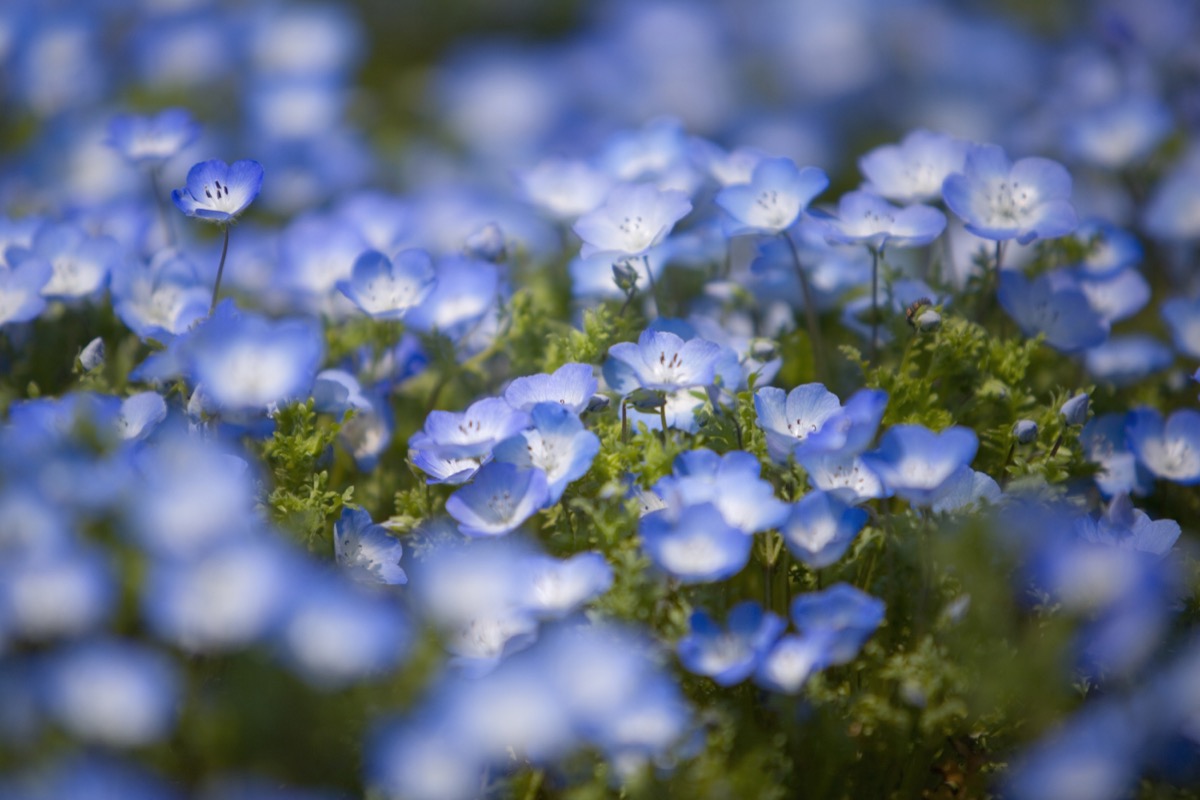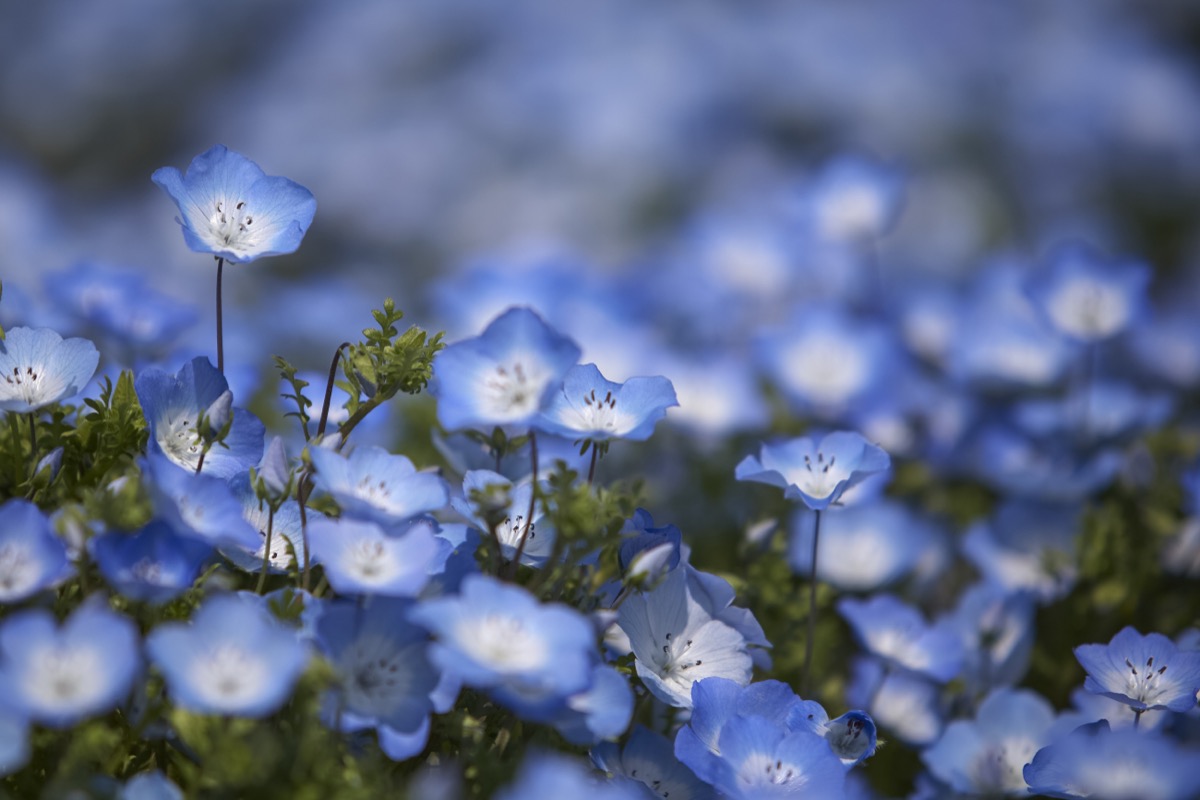Nemophila, commonly known as Baby Blue Eyes, belongs to the Boraginaceae family and is a genus of flowering plants. Baby Blue Eyes is a beautiful annual herb that adds a touch of delicate charm to any garden. These delicate flowers add a touch of charm and beauty with their soft blue petals.

How to Grow and Care for Baby Blue Eyes
Baby Blue Eyes Soil Requirements
These delicate flowers thrive in loose, organically rich, well-drained, and slightly acidic soil. This soil type provides them with the perfect conditions for growth and ensures they receive all the necessary nutrients. Prepare the soil before planting to create an ideal environment for your baby’s blue eyes. Remove weeds or rocks from the area and loosen them using a garden fork or tiller. Adding compost or organic matter can also help improve drainage and fertility.
How to Grow Baby Blue Eyes from Seeds?
- These delicate little seeds require light to germinate, so be sure not to cover them when planting. Giving them access to sunlight is crucial for successful growth.
- To get started, sow the seeds onto the surface of your soil and compress them firmly. Avoid covering the seeds, as they need direct exposure to sunlight to germinate. The optimal conditions for Baby Blue Eyes seed germination are warm temperatures between 15-21°C in either spring or fall.
- Once planted, you’ll want to ensure your Baby Blue Eyes have the right environment for healthy growth.
- Transplant your seedlings into your garden space with a spacing of 6-9 inches apart. This will give each plant enough room to flourish without overcrowding.
- Growing Baby Blue Eyes from seeds requires patience, as germination can take 7-21 days. Be attentive to watering during this time and provide consistent moisture without overwatering.
Baby Blue Eyes Planting Instructions
- Firstly, choose a location for planting. Baby Blue Eyes thrive in loose, organically rich soil that is well-drained. It prefers acidic soil and does best in full sun to part shade.
- Next, prepare the soil by loosening it up and removing any weeds or debris. This will create a good environment for the seeds to germinate and grow. Remember that Baby Blue Eyes seeds require light to germinate, so do not cover them when planting.
- Sow the seeds onto the soil’s surface and gently press them down to ensure good contact with the soil. Remember not to bury them, as they need sunlight for germination.
- Water your newly planted seeds regularly. As your plants grow, provide regular watering and monitor their sunlight needs.
- Fertilizing Baby Blue Eyes are generally unnecessary as they don’t have high nutrient requirements. However, apply a balanced fertilizer sparingly according to package instructions if you notice poor growth or pale leaves.
- Watch for common pests, such as aphids or slugs, which may damage your plants. Use organic pest control methods, like handpicking or spraying with water and soap.
Baby Blue Eyes Flower Bloom Time
Baby Blue Eyes is a cool-season annual that brings its enchanting blue blooms during spring or fall. Look for a fertilizer with equal amounts of phosphorus and potassium, which will help promote healthy root development and vibrant blooms. They create a calming atmosphere and bring a sense of serenity to your outdoor space.
In case you missed it: 10 Common Problems With Indoor Succulents: How to Fix, Treatment and Solutions

Facts about Baby Blue Eyes
| Scientific Name | Nemophila menziesii |
| Family | Boraginaceae |
| Propagation | From seed |
| Plant Type | Annuals |
| Zones | 7 to 10 |
| Seed Germination Temperatures | 15-21°C |
| Soil pH | 6.0 to 8.0 |
| Soil Drainage | Moist but well-drained |
| Exposure | Full sun, partial sun |
Baby Blue Eyes Watering Tips
Watering is a crucial aspect of caring for your Baby Blue Eyes. These delicate flowers thrive in cool, moist conditions, so watering them properly is essential to their growth and health. It’s important to keep the soil consistently moist but not overly saturated. Underwatering can cause the plants to wither and die.
Baby Blue Eyes Sunlight Needs
- Baby Blue Eyes prefer a bit of shade in the hot summer months. While they enjoy soaking up some rays, too much direct sunlight can harm these delicate flowers. So, finding a balance is key.
- Ideally, plant your Baby Blue Eyes where they can receive full sun in the morning and some afternoon shade. If you live in an area with extremely hot summers, providing more shade for your Baby Blue Eyes is essential.
Baby Blue Eyes Fertilizing Guidelines
- It’s important not to overdo it with the fertilizer. This delicate flower prefers a light touch when it comes to feeding.
- Choose a well-balanced fertilizer that is low in nitrogen, as too much nitrogen can cause excessive leaf growth in flower production.
- To apply the fertilizer, mix it according to the instructions on the package and gently work it into the soil around your Baby Blue Eyes plants. Be careful not to disturb their shallow roots while doing so.
- It’s best to fertilize Baby Blue Eyes once every four weeks during their growing season. However, if you notice any signs of nutrient deficiency, like yellowing leaves or stunted growth, you may need to increase the frequency of your fertilization.
Common Pests and Diseases of Baby Blue Eyes
- One common pest that may affect Baby Blue Eyes is aphids. These tiny insects feed on the plant sap, causing stunted growth and deformation of leaves. To combat this problem, you can use organic insecticidal soap or introduce natural predators like ladybugs to your garden.
- Another potential threat is powdery mildew, a fungal disease that appears as white patches on the leaves. This can be prevented by providing good air circulation around the plants and avoiding overhead watering.
- Root rot is another concern for Baby Blue Eyes if they are overwatered or planted in poorly draining soil. To prevent this issue, ensure adequate drainage and avoid excessive watering.
- Slugs and snails may also threaten Baby Blue Eyes by feeding on young seedlings or tender foliage. You can deter them by placing copper tape around your plants or using organic slug pellets sparingly.
Pruning and Deadheading Baby Blue Eyes
- Regular pruning helps promote healthy growth and prevents the plant from becoming leggy or overcrowded. Deadheading involves removing spent flowers to encourage more blooms throughout the season.
- To start, you’ll want to prune your Baby Blue Eyes plants in early spring before they begin actively growing. Use clean, sharp pruners to remove damaged or diseased branches at their base.
- When it comes to deadheading, snip off spent flowers with pruners or scissors just above a set of healthy leaves or buds. By removing these faded blooms, you’re redirecting energy toward new bud development instead of seed production.
Baby Blue Eyes Companion Plants
- This delicate flower adds beauty to any garden and thrives when planted alongside certain plants. The great options for a companion plant are Succulents, Cacti.
- Consider planting wildflowers like California poppy alongside your Baby Blue Eyes if you want more variety. These complementary blooms create a charming meadow-like effect in your garden.
Winter Care for Baby Blue Eyes
- Make sure to provide proper protection for your Baby Blue Eyes. Cover them with a layer of mulch to insulate the soil and protect the plant roots from freezing temperatures.
- Additionally, be mindful of watering during winter. While it’s crucial not to overwater, don’t let your plants go completely dry, either. Give them a light watering every few weeks if there is no rainfall.
- Look for any signs of disease or pests, even dormant. Treat any issues promptly to ensure your Baby Blue Eyes stay healthy throughout winter.
In case you missed it: 10 Common Problems With Marigold Flowers: How to Fix, Treatment, and Solutions

Conclusion
With its delicate and enchanting blooms, Baby Blue Eyes is a versatile flower that can be enjoyed in various garden settings. With its stunning blue flowers and easy-to-grow nature, it’s no wonder why this plant has become such a popular choice among garden enthusiasts.
- Ultimate Guide to Ossabaw Island Hog: Breeding, Raising, Diet, and Care
- Ultimate Guide to Juliana Pig: Raising Facts, Size, Diet, Care, and Lifespan
- Raising Lleyn Sheep: Disadvantages, Price, Uses, Characteristics, and Care
- Ultimate Guide to Meishan Pig: Breed Facts, Breeding, Raising, and Care
- Ultimate Guide to Teacup Pigs: Raising, Diet, Lifespan, Cost, and Care
- Guide to Raising Poll Dorset Sheep: Facts, Profile, Characteristics, Uses, and Care
- Ultimate Guide to Bighorn Sheep: Characteristics, Diet, Lifespan, Breeding, and Lifecycle
- Ultimate Guide to Raising Katahdin Sheep: Farming Facts, Breed Profile, Uses, and Care
- Ultimate Guide to Raising Oreo Cows: Belted Galloways Farming Facts, Profile, Uses, and Care